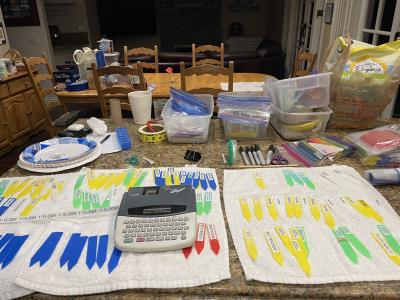




Is Treated Wood Safe to Use In Your Garden?
10/9/2023
Is it safe to treat your wood? Most people say NO-WAY. Here is what the science says.
This was frustrating and expensive. Part of what we want to do is save some money with gardening. If we have to continually replace our lumber, this is going to have an adverse economic impact on our garding.
I believe the concern from 'organic gardeners' is overstated and mostly un-scientific, and is put out there to their community based on their collective bias about using anything unnatural. If there is Science out there from credible sources, I am happy to engage in the debate and change my position.
Here is some information on this subject:
After great internal-debate and several hours of research on the internet with supplier provided information (bias-concern) and university studies and analysis (less bias-concern), I came to the conclusion that this was safe to use in my garden and the risk of this causing me health issues was very low.

Source: Reregistration Eligibility Decision for Copper and Zinc Naphthenate Salts; U.S. Environmental Protection Agency, Office of Prevention, Pesticides, and Toxic Substances, U.S. Government Printing Office: Washington, DC, 2007. http://npic.orst.edu/factsheets/treatwoodrefs.html

When trace elements such as these three are added to soil, most of what is added is not available for plant uptake. Chromium and copper are bound very strongly by soil particles, especially by soil clays and organic matter. They are most strongly bound in near-neutral soils (pH 6–8) and become more soluble in acidic soils (pH less than 5). As a result, Cr and Cu tend not to move in soil, and only a small fraction of what is added to the soil can be taken up by plants (2). The publication later emphasizes this by stating that gardeners can avoid potential plant uptake of these nutrients by “Maintain(ing) soil pH in the near-neutral range (pH 6–7). Solubility of Cr and Cu is greatly reduced in neutral soils,” and, “Maintain high soil organic matter levels by adding compost or manure. Organic matter strongly binds As, Cr, and Cu and thus reduces their availability to plants,” two things that gardeners typically do as part of their regular gardening efforts (2). Even if some copper is absorbed by plants, Pennsylvania State University states that:
…the human body can tolerate relatively large intakes of Cr and Cu and is also able to excrete excess amounts of these metals. Furthermore, plants are less tolerant of Cr and Cu than humans are. This means that Cr and Cu would kill plants before plant tissue concentrations could get high enough to cause a chronic toxic effect in humans from eating the plants
In summary, research shows that although the copper azole treatment is 96% copper and is known to leach into the surrounding soil:
Leached copper is quickly bound up in clay and organic matter so that it is highly unlikely that garden plants would absorb it. Copper is far more toxic to plants than humans, meaning that garden plants would die before carrying harmful levels of copper to the dinner table.
Copper is actually an essential nutrient for humans, and our bodies are able to absorb the needed amount, then safely pass any excess.
Source: https://seedstl.org/treated-lumber-community-garden

Copper azole – CA. Copper azole is a water-based wood preservative that prevents fungal decay and insect attack; it is a fungicide and insecticide. It is widely used throughout the United States and Canada. Type A contains copper, boric acid, and tebuconazole, while Type B only contains copper and tebuconazole. CA is a water-based preservative that can be cleaned and painted.
One 2014 study found that copper did migrate from copper azole treated wood into the soil immediately adjacent to the planter sides. Copper levels were not higher in roots or tubers of radishes, carrots or potatoes compared to beds constructed from untreated wood. Copper levels, however, were elevated in carrot foliage, which is not normally consumed. Another 2014 study found that exposure to copper that was released from the surface of CA treated wood could result in an acute toxic exposure for children less than 8 years old IF the child ingested most of the copper residue on her/his hands and feet; the copper would not be toxic dermally.
Copper azole is registered for treatment of millwork, shingles and shakes, siding, plywood, structural lumber, fence posts, building and utility poles, land and freshwater piling, composites, and other wood products that are used in above-ground, ground contact and fresh water as well as in salt water splash (marine) decking applications.
Iowa State University Information
University of Florida - Safety of Wood Products in the Garden
Some Background - My Early Days with Raised Garden Beds
About 25 years ago I made some raised garden beds and used regular old pine for my structure. After only a few years, the ants and termites had their day, and destroyed sections of my wood, making it necessary to replace them.This was frustrating and expensive. Part of what we want to do is save some money with gardening. If we have to continually replace our lumber, this is going to have an adverse economic impact on our garding.
I believe the concern from 'organic gardeners' is overstated and mostly un-scientific, and is put out there to their community based on their collective bias about using anything unnatural. If there is Science out there from credible sources, I am happy to engage in the debate and change my position.
Here is some information on this subject:
Copper-Green Wood Preservative
I chose to use Copper-Green Brown Wood Preservative that uses Copper Naphthenate, as well as pressure treated lumber that uses Copper Azole.After great internal-debate and several hours of research on the internet with supplier provided information (bias-concern) and university studies and analysis (less bias-concern), I came to the conclusion that this was safe to use in my garden and the risk of this causing me health issues was very low.
Product Details
Treat outside wood with this Copper-Green Brown Wood Preservative. Designed to protect against rot, insects, mold and fungus, it covers up to 150 sq. ft. This preservative only needs two coats and dries in 48 hours for fast protection.- Product Information
- Oil-based wood preservative suitable for exterior use where end cuts of pressure-treated lumber meet water or soil
- Mildew-, mold- and rot resistant for long-lasting use
- Helps protect wood from fungi and termites

Copper Naphthenate
Copper Naphthenate is not highly soluble in water and is only slightly mobile in soil.4,12,21 It may leach more in acidic soil than in neutral soil. It is not expected to volatilize from the woodSource: Reregistration Eligibility Decision for Copper and Zinc Naphthenate Salts; U.S. Environmental Protection Agency, Office of Prevention, Pesticides, and Toxic Substances, U.S. Government Printing Office: Washington, DC, 2007. http://npic.orst.edu/factsheets/treatwoodrefs.html

Copper Azole Pressure-Treated Lumber from Home Depot
Researchers at Pennsylvania State University have also studied copper leaching while studying CCA treated lumber for use in gardening, and discuss some of their findings in a publication. When discussing potential leaching of arsenic (As), chromium, (Cr) and copper (Cu) from the old CCA lumber, the researchers found that:When trace elements such as these three are added to soil, most of what is added is not available for plant uptake. Chromium and copper are bound very strongly by soil particles, especially by soil clays and organic matter. They are most strongly bound in near-neutral soils (pH 6–8) and become more soluble in acidic soils (pH less than 5). As a result, Cr and Cu tend not to move in soil, and only a small fraction of what is added to the soil can be taken up by plants (2). The publication later emphasizes this by stating that gardeners can avoid potential plant uptake of these nutrients by “Maintain(ing) soil pH in the near-neutral range (pH 6–7). Solubility of Cr and Cu is greatly reduced in neutral soils,” and, “Maintain high soil organic matter levels by adding compost or manure. Organic matter strongly binds As, Cr, and Cu and thus reduces their availability to plants,” two things that gardeners typically do as part of their regular gardening efforts (2). Even if some copper is absorbed by plants, Pennsylvania State University states that:
…the human body can tolerate relatively large intakes of Cr and Cu and is also able to excrete excess amounts of these metals. Furthermore, plants are less tolerant of Cr and Cu than humans are. This means that Cr and Cu would kill plants before plant tissue concentrations could get high enough to cause a chronic toxic effect in humans from eating the plants
In summary, research shows that although the copper azole treatment is 96% copper and is known to leach into the surrounding soil:
Leached copper is quickly bound up in clay and organic matter so that it is highly unlikely that garden plants would absorb it. Copper is far more toxic to plants than humans, meaning that garden plants would die before carrying harmful levels of copper to the dinner table.
Copper is actually an essential nutrient for humans, and our bodies are able to absorb the needed amount, then safely pass any excess.
Source: https://seedstl.org/treated-lumber-community-garden
2" x 8" Pressure Treated Wood From Home Depot

Iowa State University - Copper Azole
Copper azole – CA. Copper azole is a water-based wood preservative that prevents fungal decay and insect attack; it is a fungicide and insecticide. It is widely used throughout the United States and Canada. Type A contains copper, boric acid, and tebuconazole, while Type B only contains copper and tebuconazole. CA is a water-based preservative that can be cleaned and painted.
One 2014 study found that copper did migrate from copper azole treated wood into the soil immediately adjacent to the planter sides. Copper levels were not higher in roots or tubers of radishes, carrots or potatoes compared to beds constructed from untreated wood. Copper levels, however, were elevated in carrot foliage, which is not normally consumed. Another 2014 study found that exposure to copper that was released from the surface of CA treated wood could result in an acute toxic exposure for children less than 8 years old IF the child ingested most of the copper residue on her/his hands and feet; the copper would not be toxic dermally.
Copper azole is registered for treatment of millwork, shingles and shakes, siding, plywood, structural lumber, fence posts, building and utility poles, land and freshwater piling, composites, and other wood products that are used in above-ground, ground contact and fresh water as well as in salt water splash (marine) decking applications.
Iowa State University Information
Additional Resources
https://www.conradfp.com/pressure-treatment-cca-gardens-study.phpUniversity of Florida - Safety of Wood Products in the Garden
COMMENT BOARD [00078]
Please keep things family friendly, since we are a civilized community here at alanharmon.net! - (CPC Ver 0.01a)